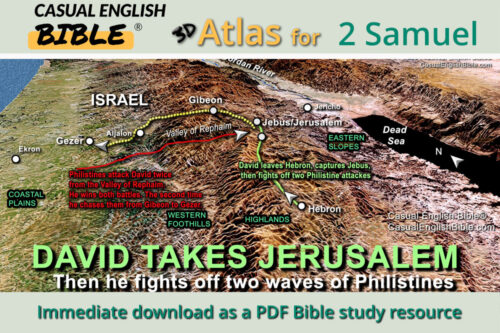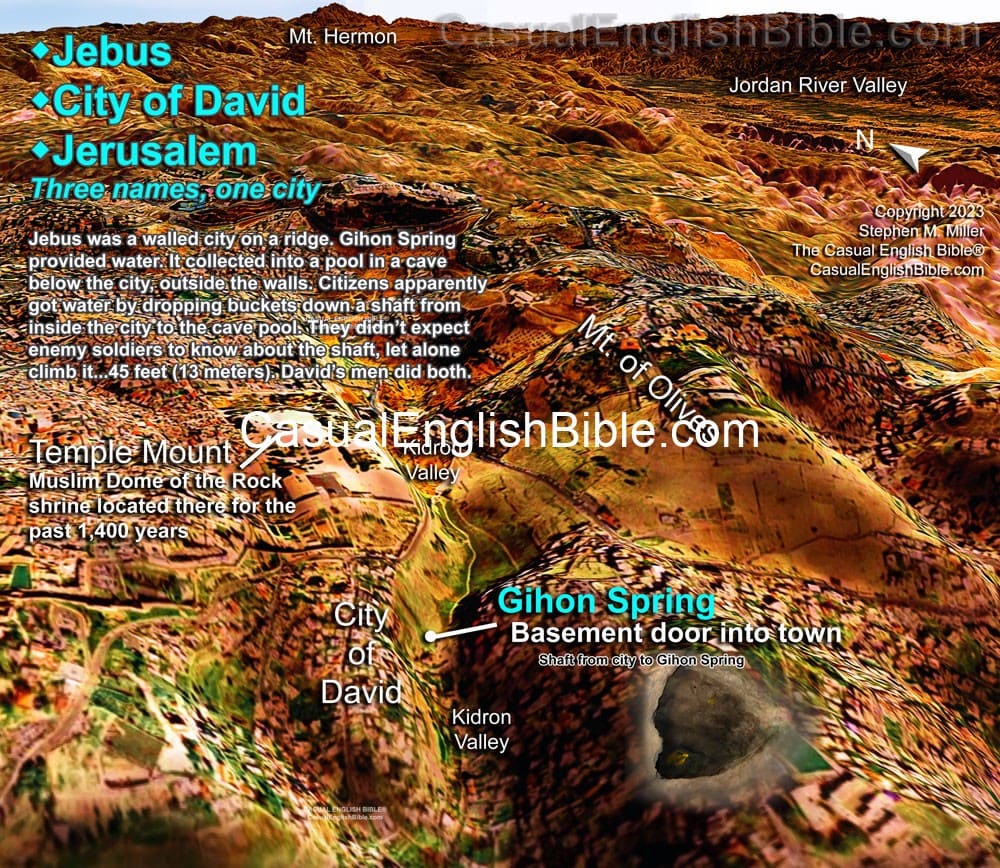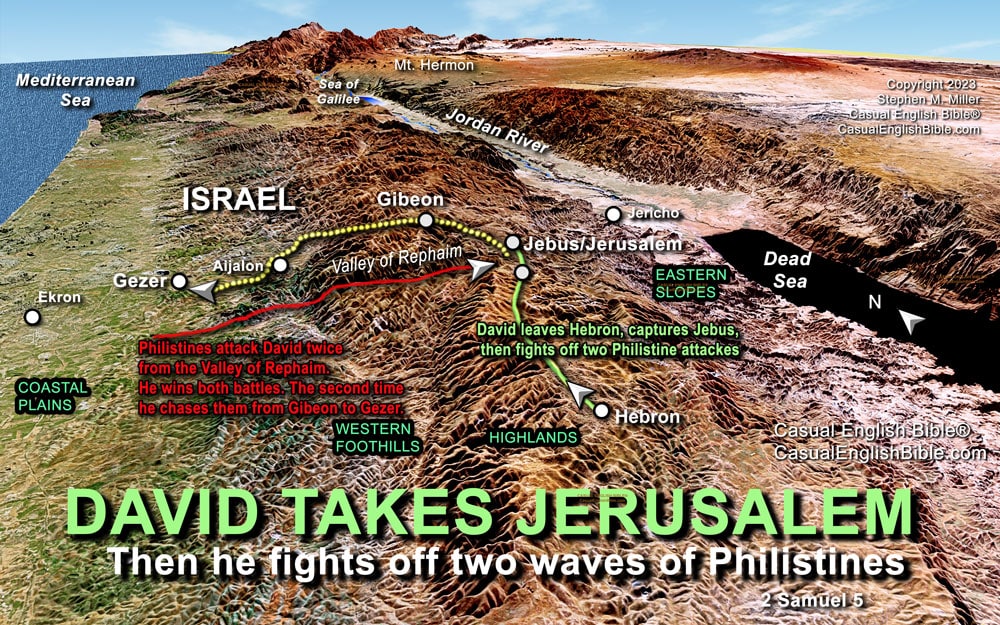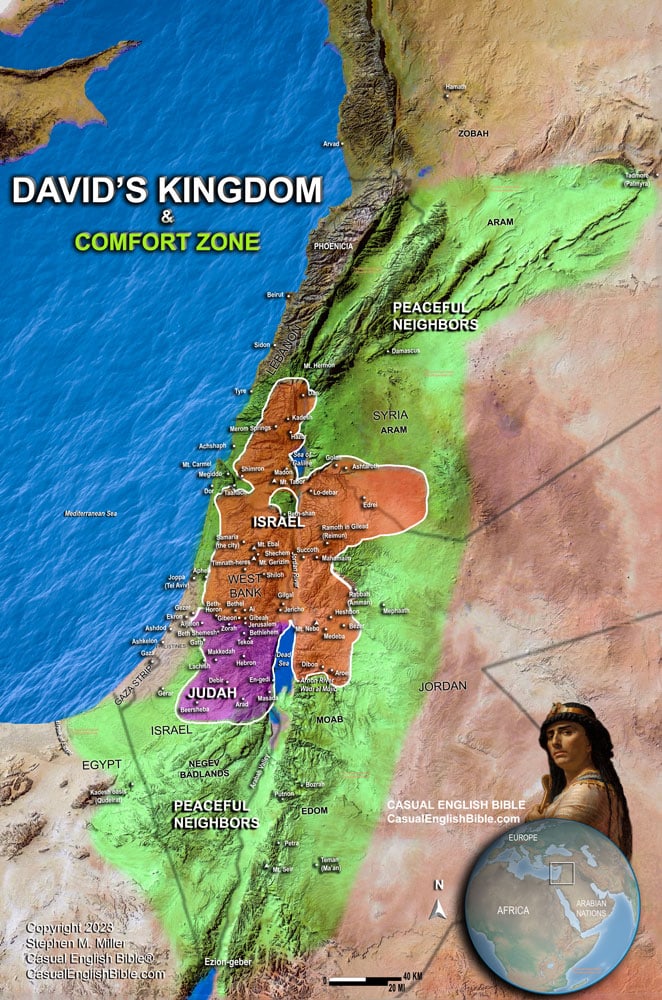2 Samuel 5
Israel crowns David their king
David, new king of Israel
1 Chronicles 11:1-3 1Israel’s tribal leaders came to see David in Hebron. They told him, “Listen, we’re family. 2When Saul was our king, you were the one who led us into battle. The LORD picked you as the next king to shepherd his people—the people of Israel. He said you would be our ruler.”
3David and the leaders agreed that he would become king over all the tribes of Israel. So, they anointed him as king. 4David was 30 years old at the time. He would reign for a generation, 40 years. [1] 5David reigned as king over the tribe of Judah for seven and a half years. Then he reigned over all of Israel including Judah for 33 years. David conquers Jerusalem
1 Chronicles 11:4-9; 14:1-17 6King David and his men marched north to Jerusalem. They intended to take the city from Jebusite people who lived there. Jebusites were so confident of their defenses that they yelled down to David, “Hey, you can’t get in here. A blind cripple could stop you.” 7David took the walled city anyhow. People sometimes call the city Zion. But David called it the City of David. The name stuck.
8David said, “Let’s show those blind cripples how much I hate them. To get to them, you’re going to have to climb up the shaft [2] that drops into their spring of water.” That’s where the old saying comes from, that “The lame and blind aren’t allowed in the Temple.” [3]
9David moved into the walled town and named it City of David. He fortified the position even more, from Millo [4] tower on the perimeter and then toward the center of the city. 10David became a stronger and more respected leader because the LORD of everyone was on his side.
11King Hiram decided to give David a palace as a gift. So, he sent ambassadors along with carpenters and masons, supplied with cedar trees. 12David took that as a sign that the LORD had, in fact, given him the job of king over Israel and had lifted his status for Israel’s sake. [5]
13After David moved to Jerusalem, he took more women into his harem—concubines [6] and wives. They gave him more sons and daughters. 14The names of David’s 11 children born in Jerusalem include: Shammua, Shobab, Nathan, Solomon, 15Ibhar, Elishua, Nepheg, Japhia, 16Elishama, Eliada, and Eliphelet. Philistines put a bullseye on David
17When Philistines heard David became king of Israel, they targeted him. And they came up from the coast to hunt him. David got news about that, and he retreated to his favorite fortified hiding spot. [7]
18Philistines invaded the Valley of Rephaim. [8] 19David asked the LORD, [9] “Should I attack the Philistines? Will you let me defeat them?” The LORD said, “Go on up after them. I’ll give them to you.” 20So David went to a place called The Unstoppable Lord. [10] He beat the Philistines, and gave the credit to God. He said, “The LORD plowed through my enemies like a flash flood.” That’s why the place is called The Unstoppable Lord. 21Philistines ran away, leaving their idols behind. David and his men carried the idols away. Philistines invade Israel
22Philistines invaded Rephaim Valley again. 23Once again David asked the LORD what to do. The LORD told David, “Don’t go charging into their front line. Secretly circle behind them and wait at the balsam trees. 24When you hear marching in the treetops, [11] that’s your signal. The LORD is already attacking the Philistines.”
25David did what the LORD said. He defeated the Philistines and chased them from Gibeon [12] to Gezer. Footnotes
15:4“Forty years” didn’t seem to mean 40 calendar years in ancient times. It was a common way of saying “a long time” or “a generation.” The symbolic number shows up about 150 times in the Bible. It was probably intended to be taken no more literally than our modern saying “at the eleventh hour.” “Eleventh hour” means at the last moment, not 11 o-clock.
25:8The vertical shaft is known as Warren’s Shaft, named after British engineer Sir Charles Warren, who rediscovered it in 1867. The shaft functioned like a chimney or a well that dropped about 13 meters (roughly 45 feet) into a cave that held Gihon Spring, Jerusalem’s main source of water. The cave and the spring were below the ridgetop city and outside the walled defenses in David’s time.
35:8“Temple” is from the Hebrew word bayit, which can also refer to a house, a palace, or land. But scholars say it’s most likely a reference to God House, the Jerusalem Temple, which David’s son Solomon built.
45:9What “Millo” means is a mystery. One theory is that it refers to a terraced part of the ridge with a stairstep citadel. Archaeologist Kathleen Kenyon found in the oldest part of Jerusalem a Stepped Stone Structure, as it’s called. It’s dated to the time of David and his son Solomon, about 1000-900 BC. Some say the structure was the foundation for a royal palace that endured for six centuries—until Babylonian invaders from what is now Iraq leveled Jerusalem and the Temple in 586 BC.
55:12A greater king meant a greater Israel.
65:13Concubines were women who lived with a man in a legally binding relationship as secondary wives, but who had less social status and fewer perks than a wife (1 Kings 11:3). With King Saul dead, his concubines became Ishbosheth’s property. If Abner did sleep with Rizpah, he was perhaps exerting his power over the king, revealing Ishbosheth as more of a pretend king than one with real power.
75:17More literally “fortress” or “stronghold.” Many scholars say the writer was talking about Adullam (1 Samuel 22:1, 4). Some scholars link a ruin known as Tel Adullam to the ancient city of Adullam. It’s about a half-day walk southwest of David’s hometown of Bethlehem, roughly 13 miles (21 km). And it’s about 10 miles (16 km) southeast of the ruin Tel es-Safi, linked to Gath. David used a cave in Adullam as an HQ for gathering information and making plans (1 Samuel 22:1-2).
85:18Rephaim Valley descends southwest of Jerusalem, toward the Mediterranean coast in the west and to an ancient trail between the coast and the Judean Hills.
95:19One of the common ways to ask the LORD for something was to ask the high priest. For an answer, he could use two objects that Israelites called the Urim and Thummim. The Urim and Thummin, meaning “lights” and “perfection,” were two objects the high priest used to answer questions with a “yes” or “no” or “wait.” Bible writers never describe them. But they might have been stones, marked or colored in different ways. It might have worked a bit like tossing two coins in the air and seeing how they land. Two heads for “yes.” Two tails for “no.” One of each for “wait.” It might seem foolish to make an important decision that way, such as whether to go to war. But the people of Israel seemed to believe that God controlled the objects the priests used. That doesn’t mean the Bible endorses making decisions that way today. As in, two heads up for a four-wheeler or two tails up for retirement savings.
105:20“The Unstoppable Lord” is Baal-perazim in the original Hebrew. “Baal” can refer to the Canaanite god by that name or gods or lords (human). Perazim is a word that describes something that breaks through whatever stands in its way, like a flashflood would or an overwhelming military force. The name may have originally been the name of the local god. But after David arrived, the name seemed to best describe the power of God.
115:24The sound in the treetops may have been wind rustling the leaves. Bible writers often associate God’s arrival with the sound of wind. Perhaps the most famous example is on the Day of Pentecost when the Holy Spirit descended on the followers of Jesus after his death and ascension. “It sounded like a violent blast of wind” (Acts 2:2).
125:25Some copies of ancient manuscripts say “Geba.” First Chronicles 14:16 says it’s Gibeon, which was closer to the main trail between Jerusalem and the coast. The chase from Gibeon to Gezer was roughly 15 miles (about 25 km). That’s almost a day’s travel, walking. Maybe half that if you’re running for your life.
Discussion Questions
- Sorry, there are currently no questions for this chapter.
Videos
3David and the leaders agreed that he would become king over all the tribes of Israel. So, they anointed him as king. 4David was 30 years old at the time. He would reign for a generation, 40 years. [1] 5David reigned as king over the tribe of Judah for seven and a half years. Then he reigned over all of Israel including Judah for 33 years.
David conquers Jerusalem
1 Chronicles 11:4-9; 14:1-17 6King David and his men marched north to Jerusalem. They intended to take the city from Jebusite people who lived there. Jebusites were so confident of their defenses that they yelled down to David, “Hey, you can’t get in here. A blind cripple could stop you.” 7David took the walled city anyhow. People sometimes call the city Zion. But David called it the City of David. The name stuck.
8David said, “Let’s show those blind cripples how much I hate them. To get to them, you’re going to have to climb up the shaft [2] that drops into their spring of water.” That’s where the old saying comes from, that “The lame and blind aren’t allowed in the Temple.” [3]
9David moved into the walled town and named it City of David. He fortified the position even more, from Millo [4] tower on the perimeter and then toward the center of the city. 10David became a stronger and more respected leader because the LORD of everyone was on his side.
11King Hiram decided to give David a palace as a gift. So, he sent ambassadors along with carpenters and masons, supplied with cedar trees. 12David took that as a sign that the LORD had, in fact, given him the job of king over Israel and had lifted his status for Israel’s sake. [5]
13After David moved to Jerusalem, he took more women into his harem—concubines [6] and wives. They gave him more sons and daughters. 14The names of David’s 11 children born in Jerusalem include: Shammua, Shobab, Nathan, Solomon, 15Ibhar, Elishua, Nepheg, Japhia, 16Elishama, Eliada, and Eliphelet. Philistines put a bullseye on David
17When Philistines heard David became king of Israel, they targeted him. And they came up from the coast to hunt him. David got news about that, and he retreated to his favorite fortified hiding spot. [7]
18Philistines invaded the Valley of Rephaim. [8] 19David asked the LORD, [9] “Should I attack the Philistines? Will you let me defeat them?” The LORD said, “Go on up after them. I’ll give them to you.” 20So David went to a place called The Unstoppable Lord. [10] He beat the Philistines, and gave the credit to God. He said, “The LORD plowed through my enemies like a flash flood.” That’s why the place is called The Unstoppable Lord. 21Philistines ran away, leaving their idols behind. David and his men carried the idols away. Philistines invade Israel
22Philistines invaded Rephaim Valley again. 23Once again David asked the LORD what to do. The LORD told David, “Don’t go charging into their front line. Secretly circle behind them and wait at the balsam trees. 24When you hear marching in the treetops, [11] that’s your signal. The LORD is already attacking the Philistines.”
25David did what the LORD said. He defeated the Philistines and chased them from Gibeon [12] to Gezer. Footnotes
15:4“Forty years” didn’t seem to mean 40 calendar years in ancient times. It was a common way of saying “a long time” or “a generation.” The symbolic number shows up about 150 times in the Bible. It was probably intended to be taken no more literally than our modern saying “at the eleventh hour.” “Eleventh hour” means at the last moment, not 11 o-clock.
25:8The vertical shaft is known as Warren’s Shaft, named after British engineer Sir Charles Warren, who rediscovered it in 1867. The shaft functioned like a chimney or a well that dropped about 13 meters (roughly 45 feet) into a cave that held Gihon Spring, Jerusalem’s main source of water. The cave and the spring were below the ridgetop city and outside the walled defenses in David’s time.
35:8“Temple” is from the Hebrew word bayit, which can also refer to a house, a palace, or land. But scholars say it’s most likely a reference to God House, the Jerusalem Temple, which David’s son Solomon built.
45:9What “Millo” means is a mystery. One theory is that it refers to a terraced part of the ridge with a stairstep citadel. Archaeologist Kathleen Kenyon found in the oldest part of Jerusalem a Stepped Stone Structure, as it’s called. It’s dated to the time of David and his son Solomon, about 1000-900 BC. Some say the structure was the foundation for a royal palace that endured for six centuries—until Babylonian invaders from what is now Iraq leveled Jerusalem and the Temple in 586 BC.
55:12A greater king meant a greater Israel.
65:13Concubines were women who lived with a man in a legally binding relationship as secondary wives, but who had less social status and fewer perks than a wife (1 Kings 11:3). With King Saul dead, his concubines became Ishbosheth’s property. If Abner did sleep with Rizpah, he was perhaps exerting his power over the king, revealing Ishbosheth as more of a pretend king than one with real power.
75:17More literally “fortress” or “stronghold.” Many scholars say the writer was talking about Adullam (1 Samuel 22:1, 4). Some scholars link a ruin known as Tel Adullam to the ancient city of Adullam. It’s about a half-day walk southwest of David’s hometown of Bethlehem, roughly 13 miles (21 km). And it’s about 10 miles (16 km) southeast of the ruin Tel es-Safi, linked to Gath. David used a cave in Adullam as an HQ for gathering information and making plans (1 Samuel 22:1-2).
85:18Rephaim Valley descends southwest of Jerusalem, toward the Mediterranean coast in the west and to an ancient trail between the coast and the Judean Hills.
95:19One of the common ways to ask the LORD for something was to ask the high priest. For an answer, he could use two objects that Israelites called the Urim and Thummim. The Urim and Thummin, meaning “lights” and “perfection,” were two objects the high priest used to answer questions with a “yes” or “no” or “wait.” Bible writers never describe them. But they might have been stones, marked or colored in different ways. It might have worked a bit like tossing two coins in the air and seeing how they land. Two heads for “yes.” Two tails for “no.” One of each for “wait.” It might seem foolish to make an important decision that way, such as whether to go to war. But the people of Israel seemed to believe that God controlled the objects the priests used. That doesn’t mean the Bible endorses making decisions that way today. As in, two heads up for a four-wheeler or two tails up for retirement savings.
105:20“The Unstoppable Lord” is Baal-perazim in the original Hebrew. “Baal” can refer to the Canaanite god by that name or gods or lords (human). Perazim is a word that describes something that breaks through whatever stands in its way, like a flashflood would or an overwhelming military force. The name may have originally been the name of the local god. But after David arrived, the name seemed to best describe the power of God.
115:24The sound in the treetops may have been wind rustling the leaves. Bible writers often associate God’s arrival with the sound of wind. Perhaps the most famous example is on the Day of Pentecost when the Holy Spirit descended on the followers of Jesus after his death and ascension. “It sounded like a violent blast of wind” (Acts 2:2).
125:25Some copies of ancient manuscripts say “Geba.” First Chronicles 14:16 says it’s Gibeon, which was closer to the main trail between Jerusalem and the coast. The chase from Gibeon to Gezer was roughly 15 miles (about 25 km). That’s almost a day’s travel, walking. Maybe half that if you’re running for your life.
Discussion Questions
- Sorry, there are currently no questions for this chapter.
Videos
8David said, “Let’s show those blind cripples how much I hate them. To get to them, you’re going to have to climb up the shaft [2] that drops into their spring of water.” That’s where the old saying comes from, that “The lame and blind aren’t allowed in the Temple.” [3]
9David moved into the walled town and named it City of David. He fortified the position even more, from Millo [4] tower on the perimeter and then toward the center of the city. 10David became a stronger and more respected leader because the LORD of everyone was on his side.
11King Hiram decided to give David a palace as a gift. So, he sent ambassadors along with carpenters and masons, supplied with cedar trees. 12David took that as a sign that the LORD had, in fact, given him the job of king over Israel and had lifted his status for Israel’s sake. [5]
13After David moved to Jerusalem, he took more women into his harem—concubines [6] and wives. They gave him more sons and daughters. 14The names of David’s 11 children born in Jerusalem include: Shammua, Shobab, Nathan, Solomon, 15Ibhar, Elishua, Nepheg, Japhia, 16Elishama, Eliada, and Eliphelet.
Philistines put a bullseye on David
17When Philistines heard David became king of Israel, they targeted him. And they came up from the coast to hunt him. David got news about that, and he retreated to his favorite fortified hiding spot. [7]18Philistines invaded the Valley of Rephaim. [8] 19David asked the LORD, [9] “Should I attack the Philistines? Will you let me defeat them?” The LORD said, “Go on up after them. I’ll give them to you.” 20So David went to a place called The Unstoppable Lord. [10] He beat the Philistines, and gave the credit to God. He said, “The LORD plowed through my enemies like a flash flood.” That’s why the place is called The Unstoppable Lord. 21Philistines ran away, leaving their idols behind. David and his men carried the idols away.
Philistines invade Israel
22Philistines invaded Rephaim Valley again. 23Once again David asked the LORD what to do. The LORD told David, “Don’t go charging into their front line. Secretly circle behind them and wait at the balsam trees. 24When you hear marching in the treetops, [11] that’s your signal. The LORD is already attacking the Philistines.”25David did what the LORD said. He defeated the Philistines and chased them from Gibeon [12] to Gezer.
Footnotes
“Forty years” didn’t seem to mean 40 calendar years in ancient times. It was a common way of saying “a long time” or “a generation.” The symbolic number shows up about 150 times in the Bible. It was probably intended to be taken no more literally than our modern saying “at the eleventh hour.” “Eleventh hour” means at the last moment, not 11 o-clock.
The vertical shaft is known as Warren’s Shaft, named after British engineer Sir Charles Warren, who rediscovered it in 1867. The shaft functioned like a chimney or a well that dropped about 13 meters (roughly 45 feet) into a cave that held Gihon Spring, Jerusalem’s main source of water. The cave and the spring were below the ridgetop city and outside the walled defenses in David’s time.
“Temple” is from the Hebrew word bayit, which can also refer to a house, a palace, or land. But scholars say it’s most likely a reference to God House, the Jerusalem Temple, which David’s son Solomon built.
What “Millo” means is a mystery. One theory is that it refers to a terraced part of the ridge with a stairstep citadel. Archaeologist Kathleen Kenyon found in the oldest part of Jerusalem a Stepped Stone Structure, as it’s called. It’s dated to the time of David and his son Solomon, about 1000-900 BC. Some say the structure was the foundation for a royal palace that endured for six centuries—until Babylonian invaders from what is now Iraq leveled Jerusalem and the Temple in 586 BC.
A greater king meant a greater Israel.
Concubines were women who lived with a man in a legally binding relationship as secondary wives, but who had less social status and fewer perks than a wife (1 Kings 11:3). With King Saul dead, his concubines became Ishbosheth’s property. If Abner did sleep with Rizpah, he was perhaps exerting his power over the king, revealing Ishbosheth as more of a pretend king than one with real power.
More literally “fortress” or “stronghold.” Many scholars say the writer was talking about Adullam (1 Samuel 22:1, 4). Some scholars link a ruin known as Tel Adullam to the ancient city of Adullam. It’s about a half-day walk southwest of David’s hometown of Bethlehem, roughly 13 miles (21 km). And it’s about 10 miles (16 km) southeast of the ruin Tel es-Safi, linked to Gath. David used a cave in Adullam as an HQ for gathering information and making plans (1 Samuel 22:1-2).
Rephaim Valley descends southwest of Jerusalem, toward the Mediterranean coast in the west and to an ancient trail between the coast and the Judean Hills.
One of the common ways to ask the LORD for something was to ask the high priest. For an answer, he could use two objects that Israelites called the Urim and Thummim. The Urim and Thummin, meaning “lights” and “perfection,” were two objects the high priest used to answer questions with a “yes” or “no” or “wait.” Bible writers never describe them. But they might have been stones, marked or colored in different ways. It might have worked a bit like tossing two coins in the air and seeing how they land. Two heads for “yes.” Two tails for “no.” One of each for “wait.” It might seem foolish to make an important decision that way, such as whether to go to war. But the people of Israel seemed to believe that God controlled the objects the priests used. That doesn’t mean the Bible endorses making decisions that way today. As in, two heads up for a four-wheeler or two tails up for retirement savings.
“The Unstoppable Lord” is Baal-perazim in the original Hebrew. “Baal” can refer to the Canaanite god by that name or gods or lords (human). Perazim is a word that describes something that breaks through whatever stands in its way, like a flashflood would or an overwhelming military force. The name may have originally been the name of the local god. But after David arrived, the name seemed to best describe the power of God.
The sound in the treetops may have been wind rustling the leaves. Bible writers often associate God’s arrival with the sound of wind. Perhaps the most famous example is on the Day of Pentecost when the Holy Spirit descended on the followers of Jesus after his death and ascension. “It sounded like a violent blast of wind” (Acts 2:2).
Some copies of ancient manuscripts say “Geba.” First Chronicles 14:16 says it’s Gibeon, which was closer to the main trail between Jerusalem and the coast. The chase from Gibeon to Gezer was roughly 15 miles (about 25 km). That’s almost a day’s travel, walking. Maybe half that if you’re running for your life.
Discussion Questions
- Sorry, there are currently no questions for this chapter.









